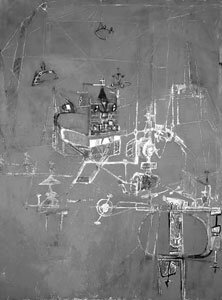Culture- ART FEATURE- Industrious evolution- Sterne's continuous flux
In 1950, when 28 rabblerousing artists co-signed a letter to the Metropolitan Museum of Art criticizing its namby-pamby approach to modern art, photographer Nina Leen posed 14 of them for a Time magazine portrait dubbed "The Irascibles." In the image, a lone woman towers over the then avant-garde group, which includes Willem de Kooning, Jackson Pollock, Mark Rothko, and Robert Motherwell. Just one woman– you'd think you'd recognize her name. But you probably don't.
It was– and is– Hedda Sterne, whose extensive career gains well-deserved exposure in the retrospective exhibition, "Uninterrupted Flux," currently on view at the University of Virginia Art Museum. The show ranges from early surreal collages to commissioned abstract paintings to pencil and pastel drawings the 96-year-old has produced during the past eight years.
Romanian and Jewish, Sterne escaped an increasingly hostile Europe for New York City in 1940. She promptly fell in love with her new country, fascinated by its vast spaces and devotion to industry. In contrast to her male Abstract Expressionist contemporaries, Sterne's monoprints and oil paintings from her first 25 years in the U.S. express an external rather than an internal focus.
The most striking images displayed in "Uninterrupted Flux" are Sterne's explorations of machinery, with the piece de resistance being "Machine #5," a large scarlet canvas into and onto which the artist has scratched white and grey line drawings of abstract, cartoon-like girders, gears, and cables, sweeping diagonally from top left to bottom right. Created over half a century ago in 1950, the work still crackles with an electric freshness.
In 1961, Fortune magazine commissioned Sterne to produce a series of oil paintings based on trips to John Deere plants in Iowa and Illinois. Using broad strokes and a gritty palette dominated by greys and yellows, the resulting semi-abstract images of farm machine details are weighty and evocative. That a European woman was the one hired to capture the aesthetic thrust of this quintessentially American and masculine realm is interesting to consider.
Another fascinating aspect of Sterne's work is how she allows her subject matter to dictate her media and technique. For instance, her expressionist paintings of American highways, inspired by a cross-country trip with her husband, required she use an airbrush to convey a sense of limitlessness.
Although art historians may have neglected Sterne's impact, "Uninterrupted Flux" offers viewers a chance to recover the space occupied by her memorable work.
"Uninterrupted Flux: Hedda Sterne, A Retrospective" is on view at the University of Virginia Art Museum through March 11. The show's curator, Sarah Eckhardt, will give a gallery talk January 26 at 5pm. 155 Rugby Road. 924-3592.

Hedda Sterne, Machine 5, 1950
#